Ultra-Wideband High-Efficiency Solar Absorber and Thermal Emitter Based on Semiconductor InAs Microstructures
Abstract
:1. Introduction
2. Model Designing and Digital Modeling
3. Conclusions Analysis and Discussion
4. Conclusions
Author Contributions
Funding
Data Availability Statement
Conflicts of Interest
References
- Malone, T.F. Comment: The World after Rio. Am. Sci. 1992, 80, 530–532. [Google Scholar]
- Wu, X.; Yin, C.; Zhang, M.; Xie, Y.; Hu, J.; Long, R.; Wu, X.; Wu, X. The Intercalation Cathode of MOFs-driven Vanadi-um-based Composite Embedded in N-doped Carbon for Aqueous Zinc ion Batteries. Chem. Eng. J. 2023, 452, 139573. [Google Scholar] [CrossRef]
- Meng, W.; Li, C.; Yao, M.; He, Z.; Wu, X.; Jiang, Z.; Dai, L.; Wang, L. Synthesis and electrochemical performance of Li1+xTi2−xFex(PO4)3/C anode for aqueous lithium ion battery. Adv. Powder Technol. 2020, 31, 1359–1364. [Google Scholar] [CrossRef]
- Wu, X.; Li, Y.; Xiang, Y.; Liu, Z.; He, Z.; Wu, X.; Li, Y.; Xiong, L.; Li, C.; Chen, J. The electrochemical performance of aqueous rechargeable battery of Zn/Na0.44MnO2 based on hybrid electrolyte. J. Power Source 2016, 336, 35–39. [Google Scholar]
- Qin, F.; Chen, J.; Liu, J.W.; Liu, L.; Tang, C.J.; Tang, B.; Li, G.F.; Zeng, L.C.; Li, H.L.; Yi, Z. Design of high efficiency perovskite solar cells based on inorganic and organic undoped double hole layer. Sol. Energy 2023, 262, 111796. [Google Scholar] [CrossRef]
- Wang, Z.; Liu, Y.; Li, L.; Gao, S.; Zhu, D.; Yu, X.; Cheng, S.; Zheng, D.; Xiong, Y. An investigation of the effects of ZnO inverse opal pore size in the composite of ZnO nanorods/ZnO inverse opal on the performance of quantum dot-sensitized solar cells. Dalton Trans. 2023, 52, 81–89. [Google Scholar] [CrossRef]
- Wu, X.; Li, Y.; Xiang, Y.; Liu, Z.; He, Z.; Wu, X.; Li, Y.; Xiong, L.; Li, C.; Chen, J. Mixed-valence cobalt oxides bifunctional electrocatalyst with rich oxygen vacancies for aqueous metal-air batteries. Chem. Eng. J. 2023, 453, 139831. [Google Scholar]
- Patel, S.K.; Han, B.B.; Alsalman, O.; Taya, S.A.; Parmar, J. Multi-layered Ti–Si solar absorber design based on tungsten material for solar thermal energy conversion. Int. J. Therm. Sci. 2023, 192, 108419. [Google Scholar] [CrossRef]
- Chen, M.; Mandal, J.; Ye, Q.; Li, A.; Yang, Y. A scalable dealloying technique to create thermally stable plasmonic nickel selective solar absorbers. ACS Appl. Energy Mater. 2019, 2, 6551–6557. [Google Scholar] [CrossRef]
- Patel, S.K.; Han, B.B.; Alsalman, O.; Rajan, B.W.; Taya, S.A.; Parmar, J. Graphene-based diamond-shaped solar absorber using Fe–SiO2–Fe structure for UV to MIR region. Int. J. Therm. Sci. 2023, 192, 108457. [Google Scholar]
- Chen, Y.H.; Zhang, C.; Yi, Z.; Wu, J.J.; Zhang, Y.B.; Bian, L.; Li, H.L. One step reactive ion etching of black germanium conical nanostructures: Ultra-wide solar spectral absorption, finite element simulation, super hydrophilicity, photothermal conversion. Sol. Energy Mater. Sol. Cells 2022, 248, 112005. [Google Scholar]
- Mastellone, M.; Bellucci, A.; Girolami, M.; Montereali, R.M.; Trucchi, D.M. Enhanced selective solar absorption of surface nanotextured semi-insulating 6h–sic. Opt. Mater. 2020, 107, 109967. [Google Scholar] [CrossRef]
- Girolami, M.; Bellucci, A.; Mastellone, M.; Orlando, S.; Valentini, V.; Montereali, R.M.; Vincenti, M.A.; Polini, R.; Trucchi, D.M. Optical characterization of double-nanotextured black diamond films. Carbon 2018, 138, 384–389. [Google Scholar] [CrossRef]
- Ren, Y.; Zhou, T.L.; Jiang, C.; Tang, B. Thermally switching between perfect absorber and asymmetric transmission in vanadium dioxide-assisted metamaterials. Opt. Express 2021, 29, 7666–7679. [Google Scholar] [CrossRef]
- Chen, Z.H.; Cai, P.G.; Wen, Q.Y.; Chen, H.; Tang, Y.J.; Yi, Z.; Wei, K.H.; Li, G.F.; Tang, B.; Yi, Y.G. Graphene Multi-Frequency Broadband and Ultra-Broadband Terahertz Absorber Based on Surface Plasmon Resonance. Electronics 2023, 12, 2655. [Google Scholar] [CrossRef]
- Tang, B.; Ren, Y. Tunable and switchable multi-functional terahertz metamaterials based on a hybrid vanadium dioxide–graphene integrated configuration. Phys. Chem. Chem. Phys. 2022, 24, 8408–8414. [Google Scholar] [CrossRef]
- Tang, B.; Yang, N.; Huang, L.; Su, J.; Jiang, C. Tunable anisotropic perfect enhancement absorption in black phospho-rus-based metasurfaces. IEEE Photonics J. 2020, 12, 4500209. [Google Scholar] [CrossRef]
- Landy, N.I.; Sajuyigbe, S.; Mock, J.J.; Smith, D.R.; Padilla, W.J. Perfect metamaterial absorber. Phys. Rev. Lett. 2008, 100, 207402. [Google Scholar] [CrossRef]
- Lai, R.; Shi, P.; Yi, Z.; Li, H.; Yi, Y. Triple-Band Surface Plasmon Resonance Metamaterial Absorber Based on Open-Ended Prohibited Sign Type Monolayer Graphene. Micromachines 2023, 14, 953. [Google Scholar]
- Li, W.; Ma, J.; Zhang, H.; Cheng, S.; Yang, W.; Yi, Z.; Yang, H.; Zhang, J.; Wu, X.; Wu, P. Tunable broadband absorber based on a layered resonant structure with a Dirac semimetal. Phys. Chem. Chem. Phys. 2023, 25, 8489–8496. [Google Scholar] [CrossRef]
- Ye, Z.; Wu, P.; Wang, H.; Jiang, S.; Huang, M.; Lei, D.; Wu, F. Multimode tunable terahertz absorber based on a quarter graphene disk structure. Results Phys. 2023, 48, 106420. [Google Scholar] [CrossRef]
- Chen, Y.S.; You, K.W.; Lin, J.Z.; Zhao, J.W.; Ma, W.Z.; Meng, D.; Liu, J. Design of a Broadband Perfect Solar Absorber Based on a Four-Layer Structure with a Cross-Shaped Resonator and Triangular Array. Photonics 2022, 9, 565. [Google Scholar] [CrossRef]
- Huang, M.H.; Wei, K.H.; Wu, P.H.; Xu, D.Y.; Xu, Y. Design of Grating Type GaAs Solar Absorber and Investigation of Its Photoelectric Characteristics. Front. Mater. 2021, 8, 781803. [Google Scholar] [CrossRef]
- Wang, Z.L.; Wei, Y.B.; Liu, Z.; Duan, G.H.; Yang, D.S.; Cheng, P. Perfect Solar Absorber with Extremely Low Infrared Emissivity. Photonics 2022, 9, 574. [Google Scholar] [CrossRef]
- Chen, H.; Li, W.; Zhu, S.M.; Hou, A.Q.; Liu, T.; Xu, J.S.; Zhang, X.W.; Yi, Z.; Yi, Y.G.; Dai, B. Study on the Thermal Distribution Characteristics of a Molten Quartz Ceramic Surface under Quartz Lamp Radiation. Micromachines 2023, 14, 1231. [Google Scholar] [CrossRef] [PubMed]
- Li, W.X.; Zhao, W.C.; Cheng, S.B.; Yang, W.X.; Yi, Z.; Li, G.F.; Zeng, L.C.; Li, H.L.; Wu, P.H.; Cai, S.S. Terahertz Selective Active Electromagnetic Absorption Film Based on Single-layer Graphene. Surf. Interfaces 2023, 40, 103042. [Google Scholar] [CrossRef]
- Jia, Z.; Huang, L.; Su, J.; Tang, B. Tunable electromagnetically induced transparency-like in graphene metasurfaces and its application as a refractive index sensor. J. Light. Technol. 2021, 39, 1544–1549. [Google Scholar] [CrossRef]
- Ma, J.; Wu, P.H.; Li, W.X.; Liang, S.R.; Shangguan, Q.Y.; Cheng, S.B.; Tian, Y.H.; Fu, J.Q.; Zhang, L.B. A five-peaks graphene absorber with multiple adjustable and high sensitivity in the far infrared band. Results Phys. 2023, 136, 109960. [Google Scholar] [CrossRef]
- Liu, W.; Liu, C.; Wang, J.X.; Lv, J.W.; Lv, Y.; Yang, L.; An, N.; Yi, Z.; Liu, Q.; Hu, C.J.; et al. Surface plasmon resonance sensor composed of microstructured optical fibers for monitoring of external and internal environments in biological and environmental sensing. Results Phys. 2023, 47, 106365. [Google Scholar] [CrossRef]
- Wu, F.Y.; Shi, P.C.; Yi, Z.; Li, H.L.; Yi, Y.G. Ultra-Broadband Solar Absorber and High-Efficiency Thermal Emitter from UV to Mid-Infrared Spectrum. Micromachines 2023, 14, 985. [Google Scholar]
- Zhu, Y.; Tang, B.; Jiang, C. Tunable broadband bandwidth anisotropic absorber based on multi-layer black phosphorus ribbons. Appl. Phys. Express 2019, 12, 032009. [Google Scholar] [CrossRef]
- Lee, D.U.; Kim, T.W.; Yoo, K.H. The dependence of the exciton transition and the Fermi energy on the InyGa1yAs well width in modulation-doped AlxGa1xAs/InyGa1yAs/GaAs strained single quantum wells. J. Mater. Sci. Lett. 2005, 240, 375–380. [Google Scholar]
- Palik, E.D. Handbook of Optical Constants of Solids; Academic Press: Cambridge, MA, USA, 1998; Volume 3. [Google Scholar]
- Wu, X.; Li, Y.; Li, C.; He, Z.; Xiang, Y.; Xiong, L.; Chen, D.; Yu, Y.; Sun, K.; He, Z.; et al. The electrochemical performance improvement of LiMn2O4/Zn based on zinc foil as the current collector and thiourea as an electrolyte additive. J. Power Source 2015, 300, 453–459. [Google Scholar] [CrossRef]
- Tang, F.; Wu, X.; Shen, Y.; Xiang, Y.; Wu, X.; Xiong, L.; Wu, X. The intercalation cathode materials of heterostructure MnS/MnO with dual ions defect embedded in N-doped carbon fibers for aqueous zinc ion batteries. Energy Storage Mater. 2022, 52, 180–188. [Google Scholar] [CrossRef]
- Liang, S.R.; Xu, F.; Li, W.X.; Yang, W.X.; Cheng, S.B.; Yang, H.; Chen, J.; Yi, Z.; Jiang, P.P. Tunable smart mid infrared thermal control emitter based on phase change material VO2 thin film. Appl. Therm. Eng. 2023, 232, 121074. [Google Scholar] [CrossRef]
- Zheng, Z.P.; Zhao, W.C.; Yi, Z.; Bian, L.; Yang, H.; Cheng, S.B.; Li, H.L.; Li, G.F.; Zeng, L.C.; Li, H.; et al. Active thermally tunable and highly sensitive terahertz smart windows based on the combination of a metamaterial and phase change material. Dalton Trans. 2023, 52, 8294. [Google Scholar] [CrossRef]
- Li, J.; Liu, G.; Liu, B.; Min, Z.; Qian, D.; Jiang, J.; Li, J. An extremely facile route to Co2P encased in N,P-codoped carbon layers: Highly efficient bifunctional electrocatalysts for ORR and OER. Int. J. Hydrogen Energy 2018, 43, 77. [Google Scholar]
- Shan, L.; Zhou, J.; Zhang, W.; Xia, C.; Guo, S.; Ma, X.; Fang, G.; Wu, X.; Liang, S. Highly Reversible Phase Transition Endows V6O13 with Enhanced Performance as Aqueous Zinc-Ion Battery Cathode. Energy Technol. 2019, 7, 57. [Google Scholar] [CrossRef]
- Liu, Y.; Wang, Z.; Li, L.; Gao, S.; Zheng, D.; Yu, X.; Wu, Q.; Yang, Q.; Zhu, D.; Yang, W.; et al. Highly efficient quantum-dot-sensitized solar cells with composite semiconductor of ZnO nanorod and oxide inverse opal in photoanode. Electrochim. Acta 2022, 412, 140145. [Google Scholar] [CrossRef]
- Zhang, Y.; Yi, Y.; Li, W.; Liang, S.; Ma, J.; Cheng, S.; Yang, W.; Yi, Y. High Absorptivity and Ultra-Wideband Solar Absorber Based on Ti-Al2O3 Cross Elliptical Disk Arrays. Coatings 2023, 13, 531. [Google Scholar] [CrossRef]
- Li, C.; Shi, X.; Liang, S.; Ma, X.; Han, M.; Wu, X.; Zhou, J. Spatially homogeneous copper foam as surface dendrite-free host for zinc metal anode. Chem. Eng. J. 2020, 379, 122248. [Google Scholar] [CrossRef]
- Liu, Z.; Zhang, H.; Fu, G.; Liu, G.; Liu, X.; Yuan, W.; Xie, Z. Colloid templated semiconductor meta-surface for ultra-broadband solar energy absorber. Sol. Energy 2020, 198, 194–201. [Google Scholar] [CrossRef]
- Zhong, H.; Liu, Z.; Tang, P.; Liu, X.; Zhan, X.; Pan, P.; Tang, C. Thermal-stability resonators for visible light full-spectrum perfect absorbers. Sol. Energy 2020, 208, 445–450. [Google Scholar] [CrossRef]
- Zheng, Y.; Wu, P.; Yang, H.; Yi, Z.; Luo, Y.; Liu, L.; Song, Q.; Pan, M.; Zhang, J.; Cai, P. High efficiency Titanium oxides and nitrides ultra-broadband solar energy absorber and thermal emitter from 200 nm to 2600 nm. Opt. Laser Technol. 2022, 150, 108002. [Google Scholar] [CrossRef]
- Li, Y.H.; Xu, Y.P.; Jiang, J.B.; Cheng, S.B.; Yi, Z.; Xiao, G.H.; Zhou, X.W.; Wang, Z.Y.; Chen, Z.Y. Polarization-sensitive multi-frequency switches and high-performance slow light based on quadruple plasmon-induced transparency in a patterned graphene-based terahertz metamaterial. Phys. Chem. Chem. Phys. 2023, 25, 3820–3833. [Google Scholar] [PubMed]
- Tang, B.; Guo, Z.; Jin, G. Polarization-controlled and symmetry-dependent multiple plasmon-induced transparency in graphene-based metasurfaces. Opt. Express 2022, 30, 35554–35566. [Google Scholar] [CrossRef] [PubMed]
- Zhu, L.; Hu, R.; Xiang, Y.; Yang, X.; Chen, Z.; Xiong, L.; Wu, X.; He, Z.; Lei, W. Enhanced performance of Li-S battery by constructing inner conductive network and outer adsorption layer sulfur-carbon composite. Int. J. Energy Res. 2020, 45, 6002–6014. [Google Scholar] [CrossRef]
- Li, W.; Yi, Y.; Yang, H.; Cheng, S.; Yang, W.X.; Zhang, H.; Yi, Z.; Yi, Y.; Li, H. Active Tunable Terahertz Bandwidth Absorber Based on single layer Graphene. Commun. Theor. Phys. 2023, 75, 045503. [Google Scholar] [CrossRef]
- Li, Y.; Yang, S.; Du, H.; Liu, Y.; Wu, X.; Yin, C.; Wang, D.; Wu, X.; He, Z.; Wu, X. A stable fluoride-based interphase for a long cycle Zn metal anode in an aqueous zinc ion battery. J. Mater. Chem. A 2022, 10, 14399–14410. [Google Scholar] [CrossRef]
- Ren, Y.; Tang, B. Switchable Multi-Functional VO2-Integrated Metamaterial Devices in the Terahertz Region. J. Light. Technol. 2021, 39, 5864–5868. [Google Scholar] [CrossRef]
- Wu, X.; Tan, C.; He, C.; Zhao, T.; Wu, X.; Ma, Z.; Wang, H.; Cai, Y.; Wu, Q.; Li, Q. Strategy for boosting Co-Nx content for oxygen reduction reaction in aqueous metal-air batteries. J. Power Source 2022, 520, 230891. [Google Scholar] [CrossRef]
- Zhu, Y.; Tang, B.; Yang, N.; Lang, X.; Su, J.; Li, Z. Tunable wide-angle perfect absorber based on black phosphorous-dielectric-metallic hybrid architecture. Phys. E 2021, 126, 114449. [Google Scholar] [CrossRef]
- Zhu, W.; Yi, Y.; Yi, Z.; Bian, L.; Yang, H.; Zhang, J.; Yu, Y.; Liu, C.; Li, G.; Wu, X. High confidence plasmonic sensor based on photonic crystal fiber with U-shaped detection channel. Phys. Chem. Chem. Phys. 2023, 25, 8583. [Google Scholar] [CrossRef] [PubMed]
- Tang, B.; Jia, Z.; Huang, L.; Su, J.; Jiang, C. Polarization-Controlled Dynamically Tunable Electromagnetically Induced Transparency-Like Effect Based on Graphene Metasurfaces. IEEE J. Sel. Top. Quantum Electron. 2021, 27, 4700406. [Google Scholar] [CrossRef]
- Wang, B.X.; Wu, C.Y.; Duan, G.Y.; Xu, W.; Pi, F.W. Review of broadband metamaterial absorbers: From principles, design strategies, and tunable properties to functiona applications. Adv. Funct. Mater. 2023, 33, 2213818. [Google Scholar]
- Tang, B.; Li, Z.; Palacios, E.; Liu, Z.; Butun, S.; Aydin, K. Chiral-Selective Plasmonic Metasurface Absorbers Operating at Visible Frequencies. IEEE Photonics Technol. Lett. 2017, 29, 295–298. [Google Scholar] [CrossRef]
- Liang, S.; Xu, F.; Yang, H.; Cheng, S.; Yang, W.; Yi, Z.; Song, Q.; Wu, P.; Chen, J.; Tang, C. Ultra long infrared metamaterial absorber with high absorption and broad band based on nano cross surrounding. Opt. Laser Technol. 2023, 158, 108789. [Google Scholar] [CrossRef]
- Shangguan, Q.; Chen, Z.; Yang, H.; Cheng, S.; Yang, W.; Yi, Z.; Wu, X.; Wang, S.; Yi, Y.; Wu, P. Design of Ultra-Narrow Band Graphene Refractive Index Sensor. Sensors 2022, 22, 6483. [Google Scholar] [CrossRef]
- Sui, J.Y.; Liao, S.Y.; Dong, R.Y.; Zhang, H.F. A Janus Logic Gate with Sensing Function. Ann. Phys. 2023, 535, 2200661. [Google Scholar] [CrossRef]
- Sui, J.Y.; Dong, R.Y.; Liao, S.Y.; Zhao, Z.Y.; Wang, Y.B.; Zhang, H.F. Janus Metastructure Based on Magnetized Plasma Material with and Logic Gate and Multiple Physical Quantity Detection. Ann. Phys. 2023, 535, 2200509. [Google Scholar] [CrossRef]
- Chen, M.M.; Yang, X.X. Tunable and three-dimensional dual-band metamaterial absorber based on electromagnetically induced transparency with vanadium dioxide. Phys. Chem. Chem. Phys. 2023, 25, 13393–13398. [Google Scholar] [CrossRef] [PubMed]
- Sun, T.; Liu, Y.; Tu, J.; Zhou, Z.; Cao, L.; Liu, X.; Yu, Z. Wafer-scale high anti-reflective nano/micro hybrid interface structures via aluminum grain dependent self-organization. Mater. Des. 2020, 194, 108960. [Google Scholar] [CrossRef]
- Liu, W.; Li, Q.; Wu, J.; Wang, W.; Jiang, R.; Zhou, C.; Wang, S.; Zhang, X.; Sun, T.; Xu, Z.; et al. Self-assembly of Au nanocrystals into large-area 3-D ordered flexible superlattice nanostructures arrays for ultrasensitive trace multi-hazard detection. J. Hazard. Mater. 2023, 443, 130124. [Google Scholar] [CrossRef] [PubMed]
- Chen, J.; Li, X.; Chen, Y.; Zhang, Z.J.; Yu, Y.; He, X.; Chen, H.; Yang, J.B.; Zhang, Z.F.; Yao, X.P. Temperature Self-Adaptive Ultra-Thin Solar Absorber Based on Optimization Algorithm. Photonics 2023, 10, 546. [Google Scholar] [CrossRef]
- Qi, Y.P.; Wang, L.; Wen, Y.J.; Chen, H.W.; Yuan, Y.J.; Zhou, Z.H.; Zhao, S.Y.; Wang, X.X. Design of a switchable bifunctional terahertz metamaterial absorber from ultra-broadband to 10-band. J. Opt. Soc. Am. B 2023, 40, 939–948. [Google Scholar] [CrossRef]
- Zheng, Y.; Yi, Z.; Liu, L.; Wu, X.W.; Liu, H.; Li, G.F.; Zeng, L.C.; Li, H.L.; Wu, P.H. Numerical simulation of efficient solar absorbers and thermal emitters based on multilayer nanodisk arrays. Appl. Therm. Eng. 2023, 230, 120841. [Google Scholar] [CrossRef]
- Matteo, M.; Maria, L.P.; Mariangela, C.; Nicola, C.; Angela, D.B.; Roberto, T.; Patrizia, D.; Donato, M.; Stefano, O.; Antonio, S.; et al. LIPSS Applied to Wide Bandgap Semiconductors and Dielectrics: Assessment and Future Perspectives. Materials 2022, 15, 1378. [Google Scholar]
- Su, J.L.; Liu, D.Q.; Sun, L.H.; Chen, G.; Ma, C.; Zhang, Q.Y.; Li, X.Y. Plasmonic Nanostructures for Broadband Solar Absorption Based on Synergistic Effect of Multiple Absorption Mechanisms. Nanomaterials 2022, 12, 4456. [Google Scholar] [CrossRef]
- Fan, Z.; Cui, D.F.; Zhang, Z.X.; Zhao, Z.; Chen, H.M.; Fan, Y.Y.; Li, P.L.; Zhang, Z.D.; Xue, C.Y.; Yan, S.B. Recent Progress of Black Silicon: From Fabrications to Applications. Nanomaterials 2021, 11, 41. [Google Scholar] [CrossRef]
- Kaoru, A.; Tomoyuki, M. Solar Cell Detection and Position, Attitude Determination by Differential Absorption Imaging in Optical Wireless Power Transmission. Photonics 2023, 10, 553. [Google Scholar]
- Hassan, S.; Mawaheb, A.D.; Mohamed, A.I.; Nashaat, S.A.E.G.; Arafa, H.A. Theoretical Analysis of Optical Properties for Amorphous Silicon Solar Cells with Adding Anti-Reflective Coating Photonic Crystals. Photonics 2022, 9, 813. [Google Scholar]

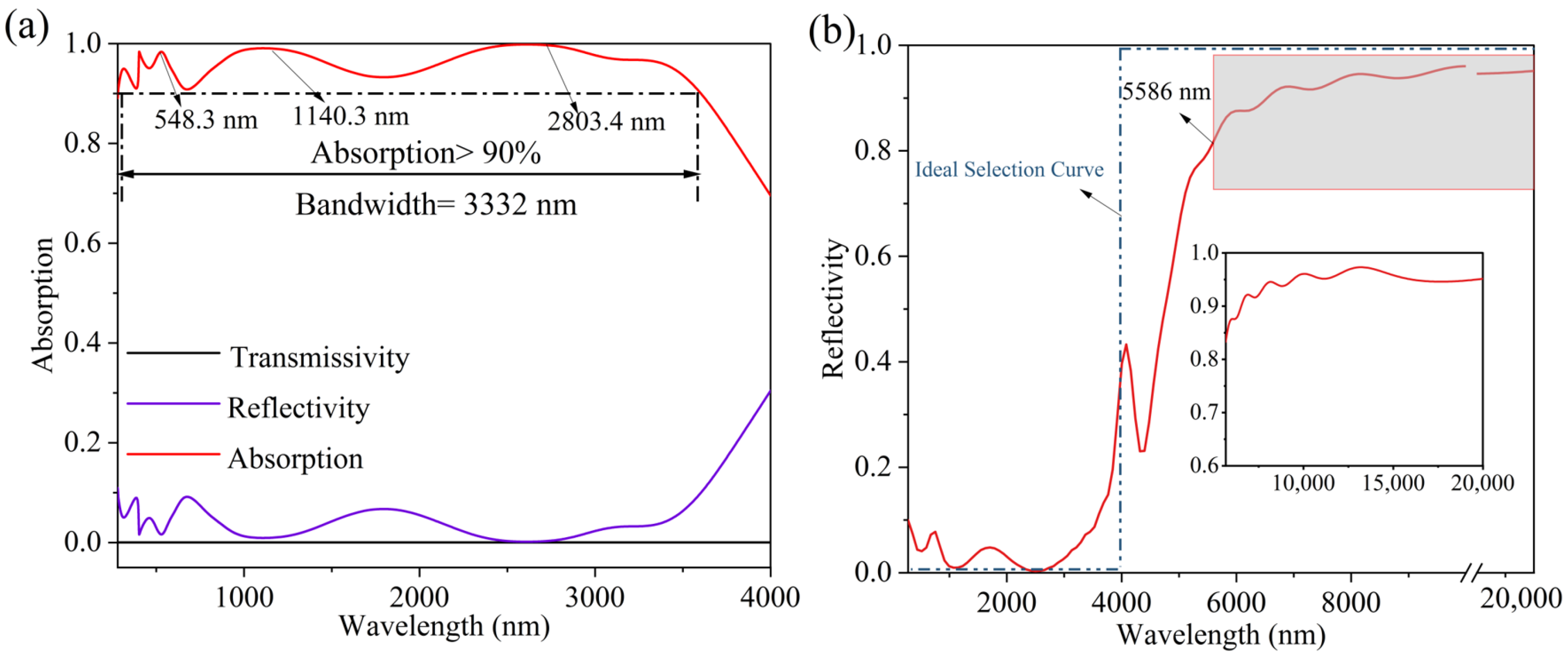
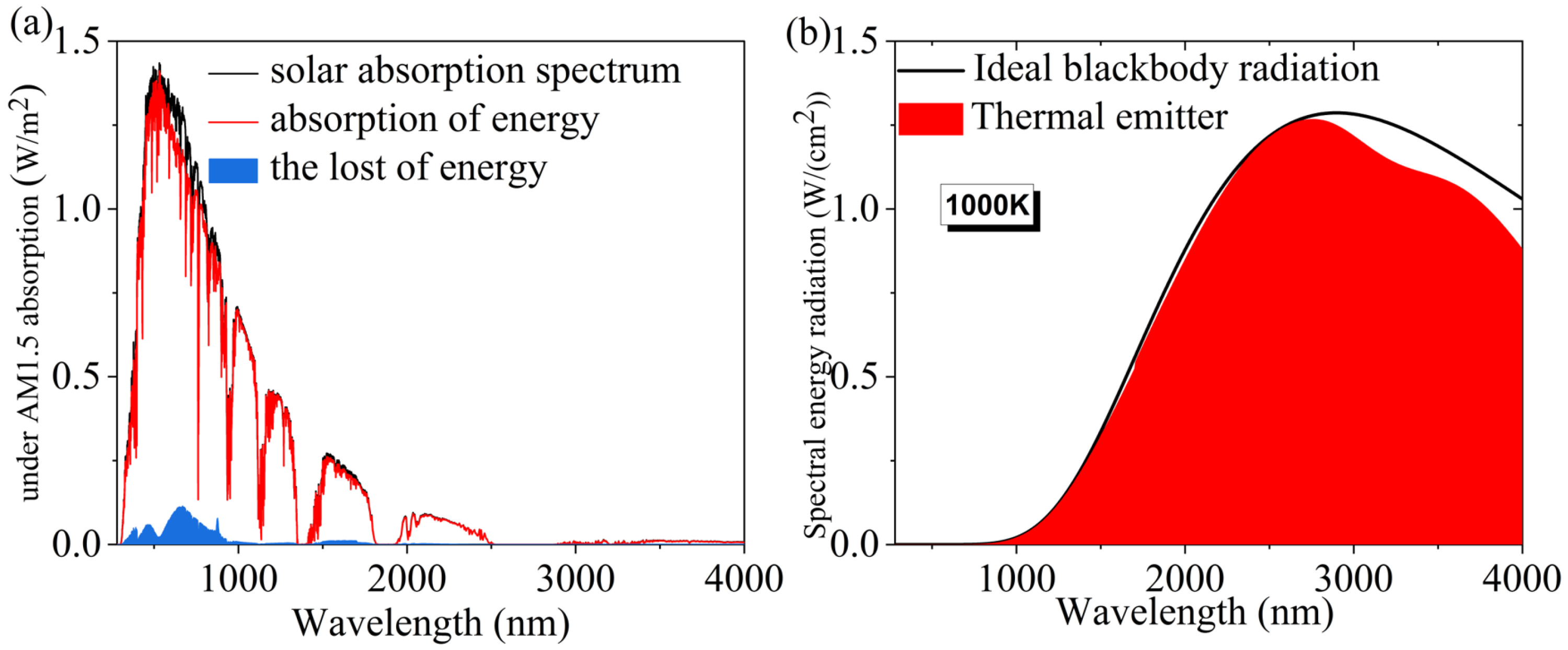


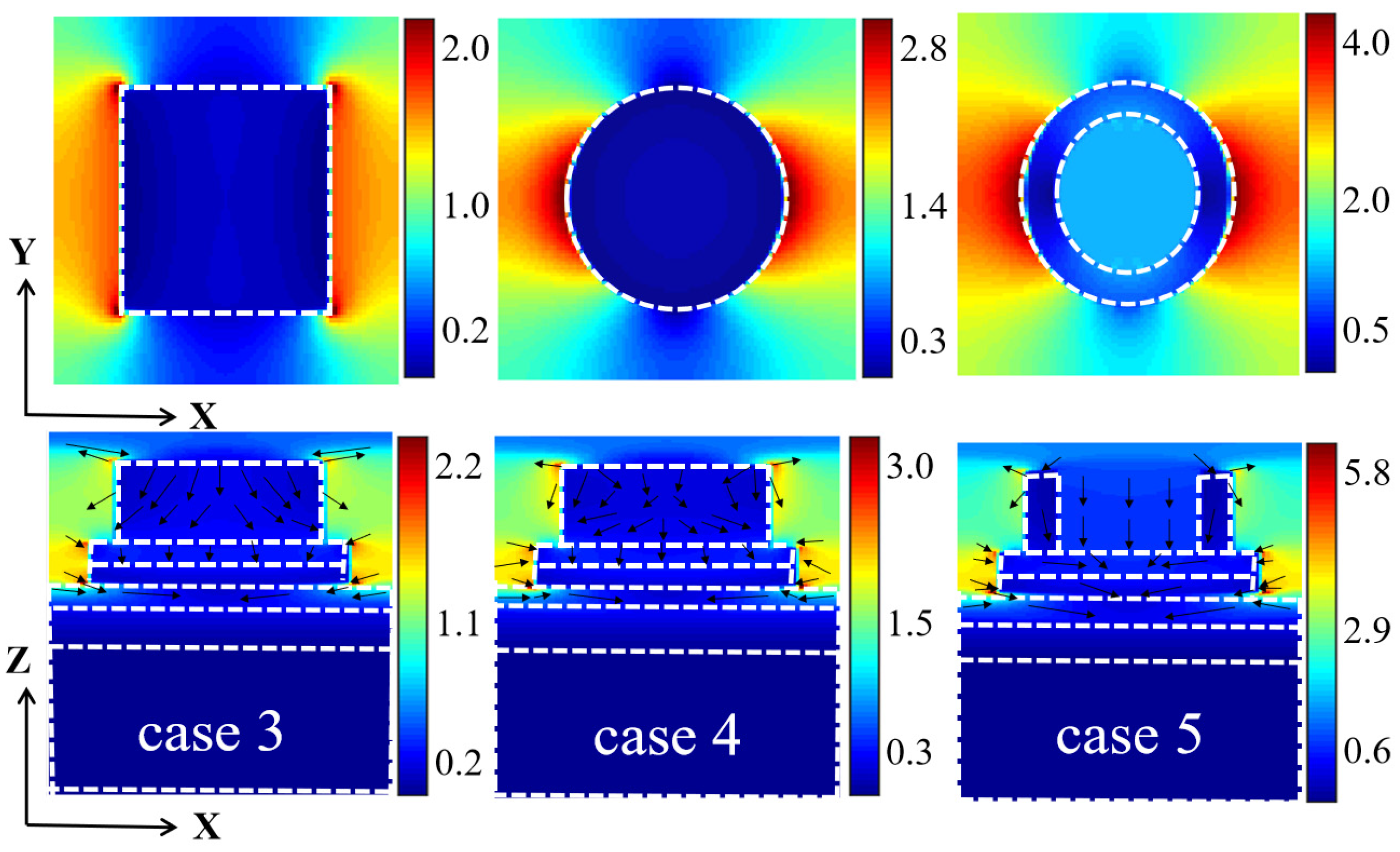
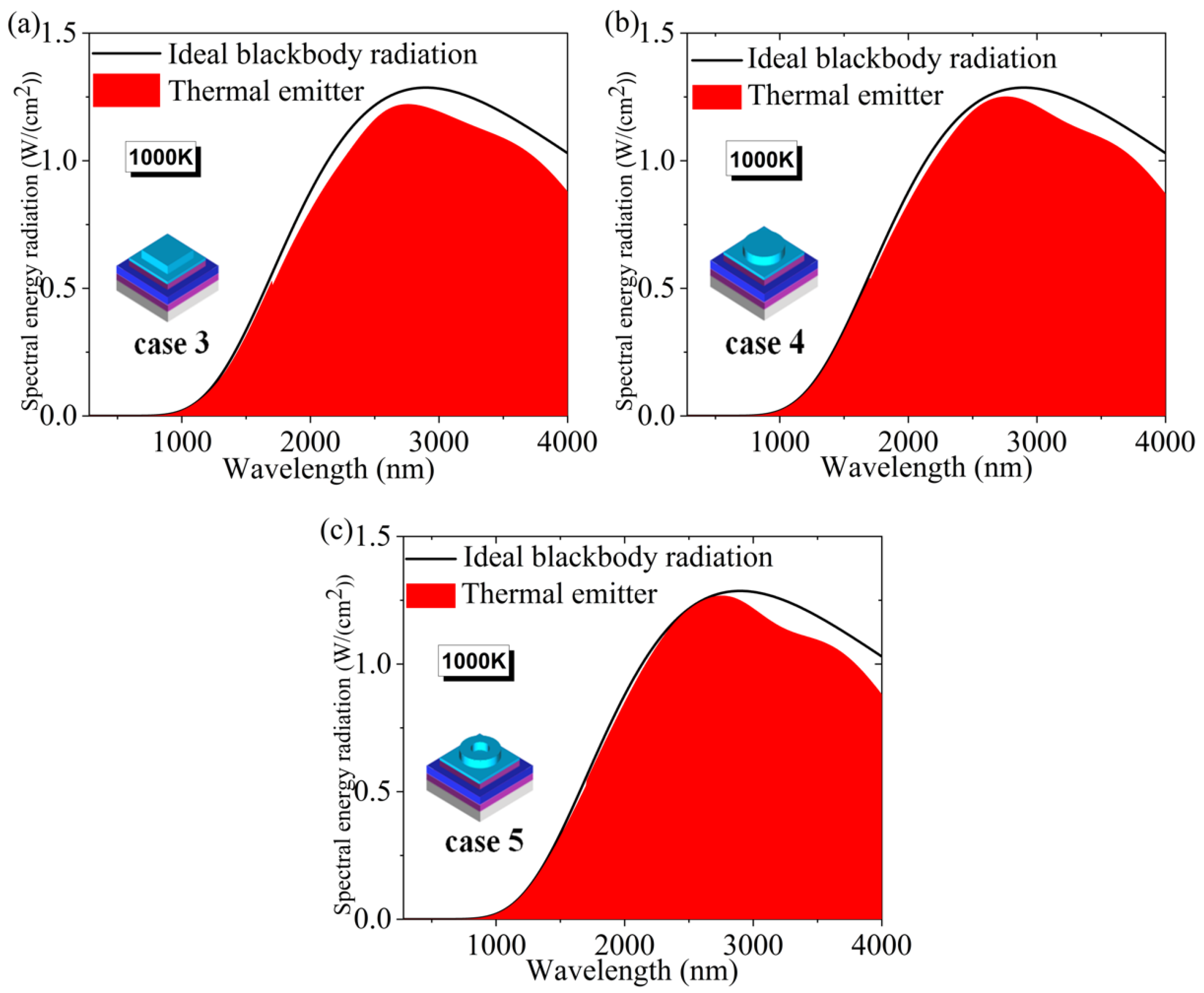
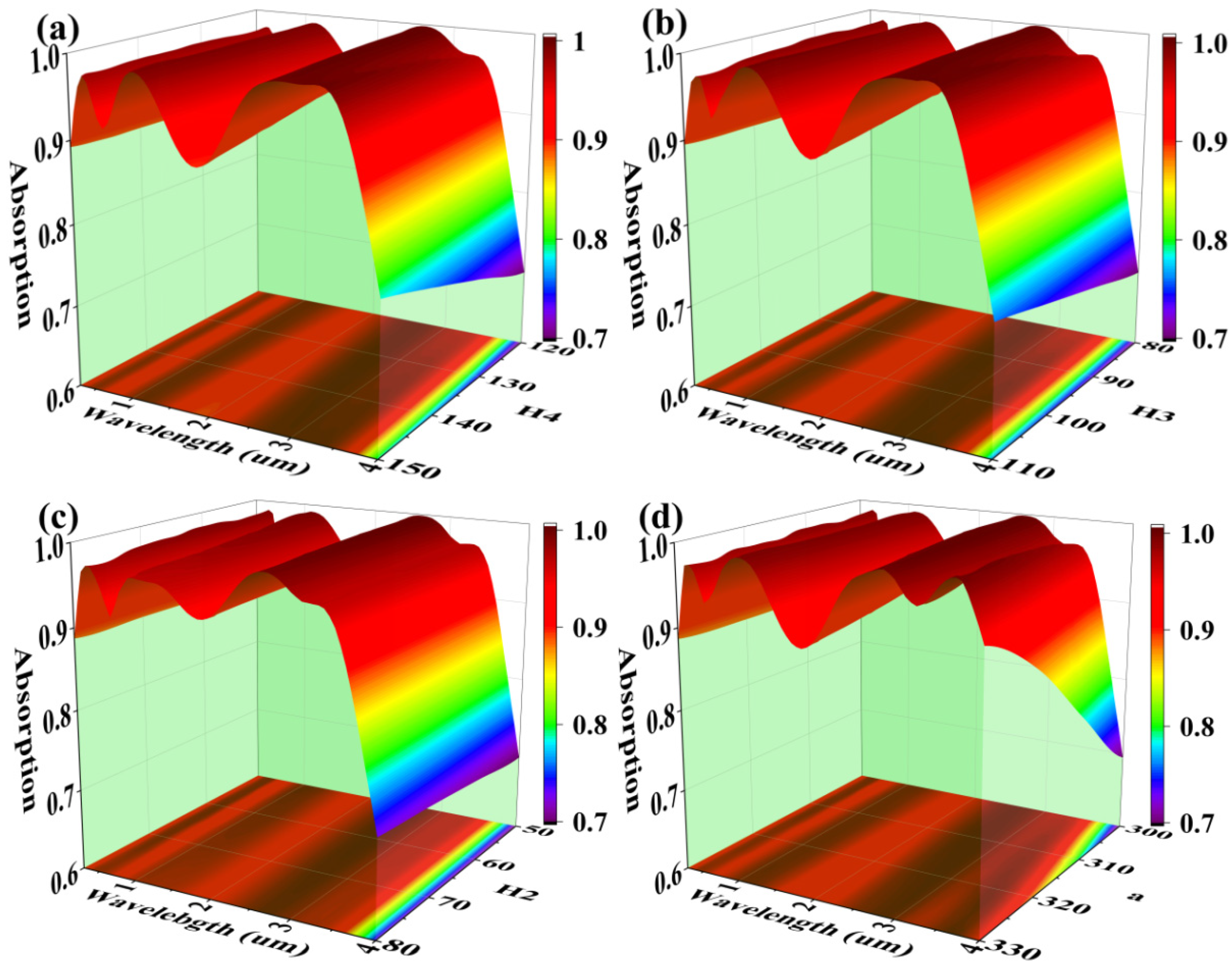
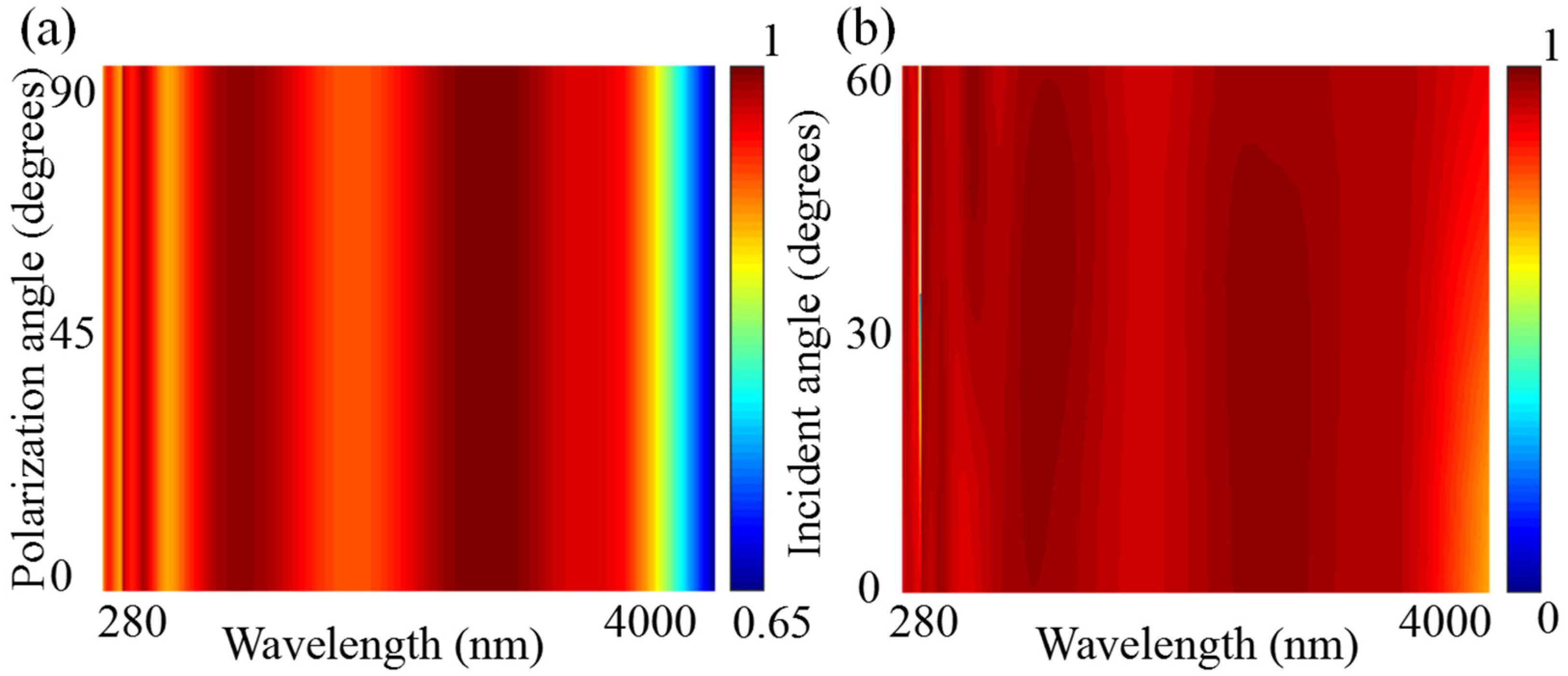
| References | Structure | Band-Width (>90%) | Absorption Efficiency | AM1.5 Absorption under Illumination |
|---|---|---|---|---|
| [43] | Ge cavity model | 1868 nm | 90% (250–3500 nm) | 88% (250–4000 nm) |
| [44] | TiO2/TiN semi-circular grating model | 475 nm | 94% (380–760 nm) | Not studied |
| [45] | TiN nano disk model | 1869 nm | 93.77% (200–2600 nm) | 95.89 (280–4000 nm) |
| [23] | GaAs grating composite structure based on W-Ti-GaAs | 2350 nm | 95% (500–2850 nm) | Not studied |
| this paper | 6-layer structure of InAs ring microstructure model | 3332 nm | 95.66% (280–4000 nm) | 95.78% (280–4000 nm) |
Disclaimer/Publisher’s Note: The statements, opinions and data contained in all publications are solely those of the individual author(s) and contributor(s) and not of MDPI and/or the editor(s). MDPI and/or the editor(s) disclaim responsibility for any injury to people or property resulting from any ideas, methods, instructions or products referred to in the content. |
© 2023 by the authors. Licensee MDPI, Basel, Switzerland. This article is an open access article distributed under the terms and conditions of the Creative Commons Attribution (CC BY) license (https://creativecommons.org/licenses/by/4.0/).
Share and Cite
Zhu, Y.; Cai, P.; Zhang, W.; Meng, T.; Tang, Y.; Yi, Z.; Wei, K.; Li, G.; Tang, B.; Yi, Y. Ultra-Wideband High-Efficiency Solar Absorber and Thermal Emitter Based on Semiconductor InAs Microstructures. Micromachines 2023, 14, 1597. https://doi.org/10.3390/mi14081597
Zhu Y, Cai P, Zhang W, Meng T, Tang Y, Yi Z, Wei K, Li G, Tang B, Yi Y. Ultra-Wideband High-Efficiency Solar Absorber and Thermal Emitter Based on Semiconductor InAs Microstructures. Micromachines. 2023; 14(8):1597. https://doi.org/10.3390/mi14081597
Chicago/Turabian StyleZhu, Yanying, Pinggen Cai, Wenlong Zhang, Tongyu Meng, Yongjian Tang, Zao Yi, Kaihua Wei, Gongfa Li, Bin Tang, and Yougen Yi. 2023. "Ultra-Wideband High-Efficiency Solar Absorber and Thermal Emitter Based on Semiconductor InAs Microstructures" Micromachines 14, no. 8: 1597. https://doi.org/10.3390/mi14081597





